Target Marketing: Market Segmentation and Customer Loyalty in Tourism
VerifiedAdded on 2023/06/14
|8
|2345
|61
Report
AI Summary
This report analyzes the role of target marketing, market segmentation, and integrated marketing channels in fostering long-term customer loyalty and driving growth within the tourism industry, with a specific focus on the Australian market. It examines various segmentation criteria, including geographic, demographic, behavioral, and psychographic factors, and discusses how these can be leveraged to create effective target marketing strategies. Furthermore, the report explores the use of integrated marketing channels such as website development, advertising, engagement marketing, social media, popular travel websites, and partnerships to reach target audiences and build brand awareness. It also outlines several techniques for cultivating customer loyalty, including gathering customer feedback, managing employees effectively, providing excellent customer care, rewarding customers, ensuring high-quality services, and following up with customers. The report concludes that a strategic approach to target marketing and customer loyalty is essential for the success and sustainable growth of tourism businesses.

Report Writing
Paraphrase This Document
Need a fresh take? Get an instant paraphrase of this document with our AI Paraphraser
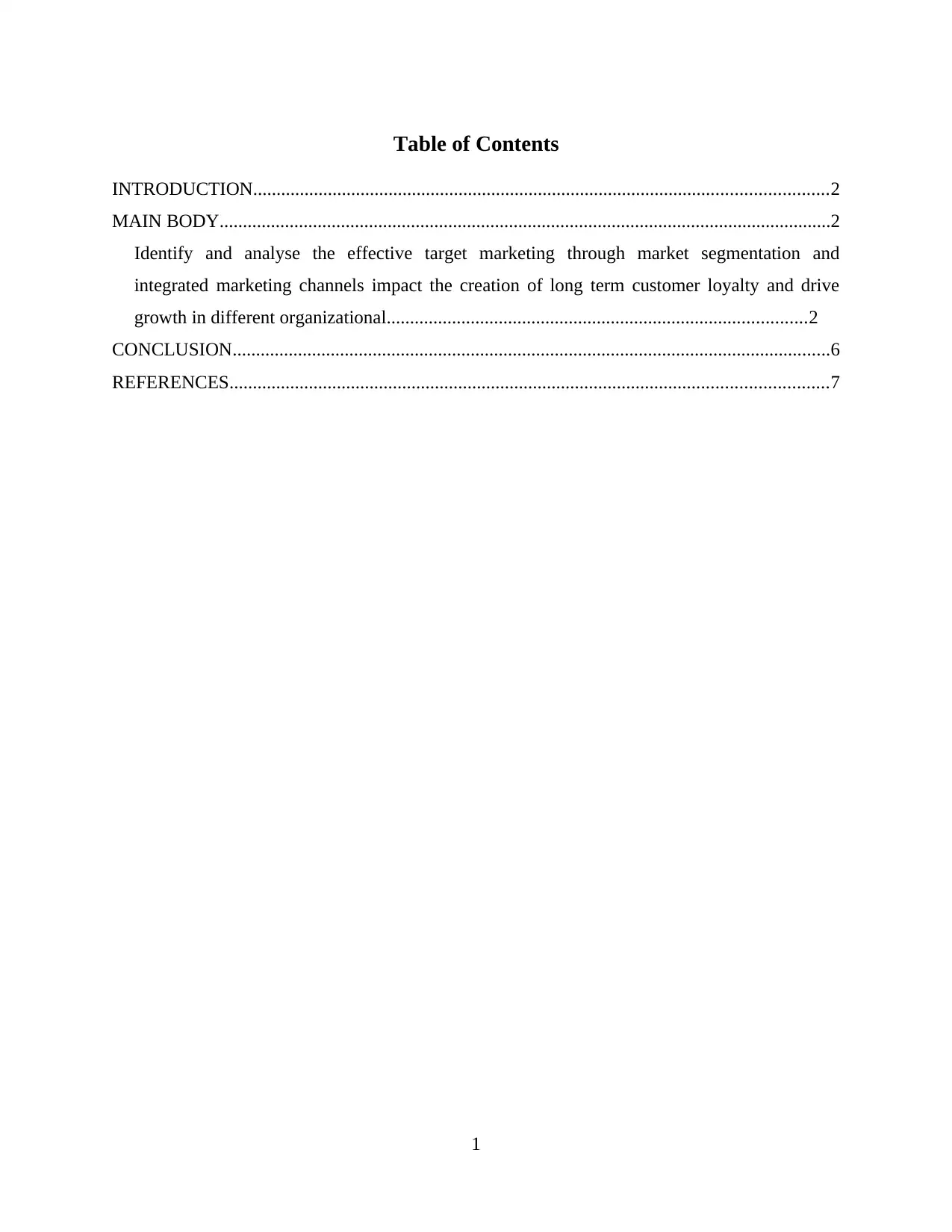
Table of Contents
INTRODUCTION...........................................................................................................................2
MAIN BODY...................................................................................................................................2
Identify and analyse the effective target marketing through market segmentation and
integrated marketing channels impact the creation of long term customer loyalty and drive
growth in different organizational..........................................................................................2
CONCLUSION................................................................................................................................6
REFERENCES................................................................................................................................7
1
INTRODUCTION...........................................................................................................................2
MAIN BODY...................................................................................................................................2
Identify and analyse the effective target marketing through market segmentation and
integrated marketing channels impact the creation of long term customer loyalty and drive
growth in different organizational..........................................................................................2
CONCLUSION................................................................................................................................6
REFERENCES................................................................................................................................7
1
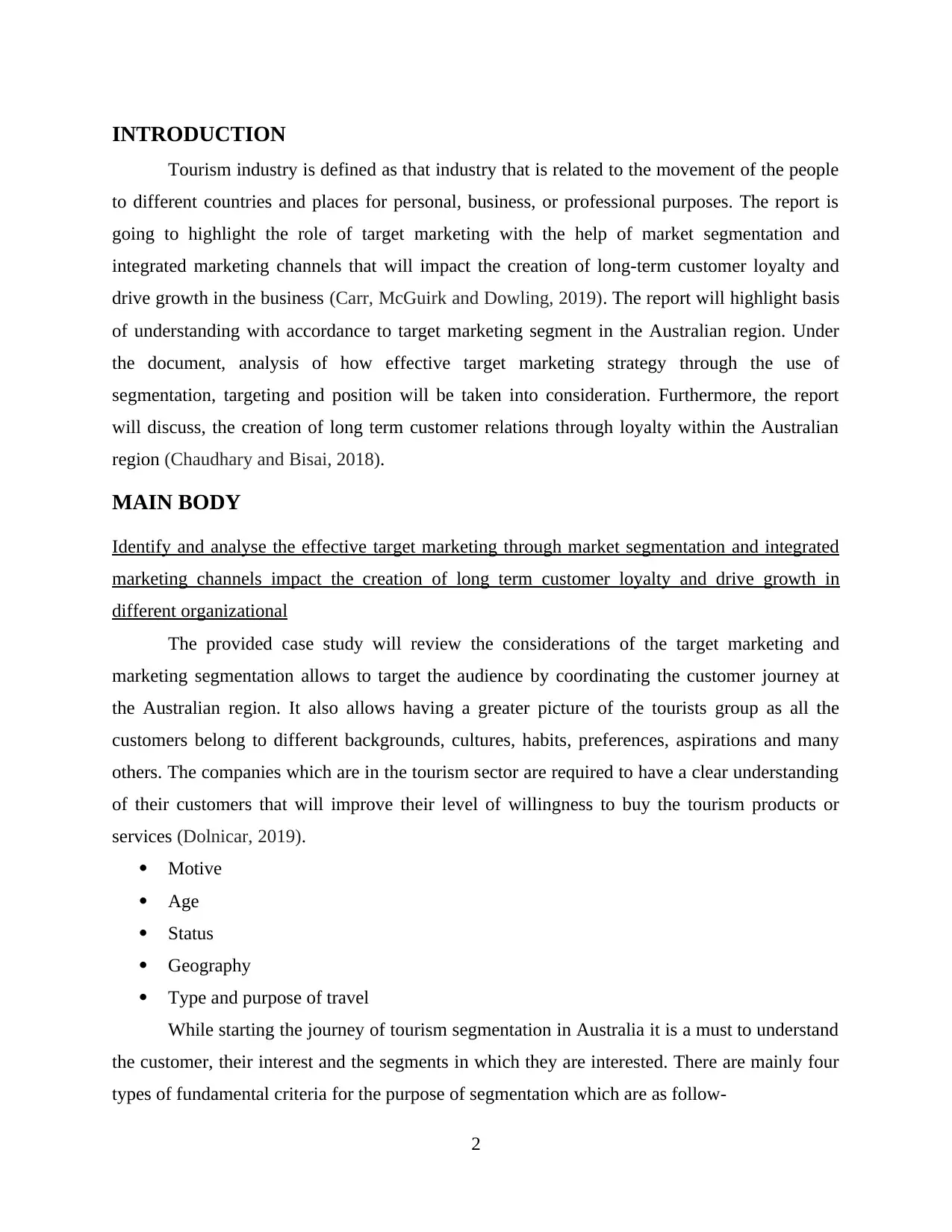
INTRODUCTION
Tourism industry is defined as that industry that is related to the movement of the people
to different countries and places for personal, business, or professional purposes. The report is
going to highlight the role of target marketing with the help of market segmentation and
integrated marketing channels that will impact the creation of long-term customer loyalty and
drive growth in the business (Carr, McGuirk and Dowling, 2019). The report will highlight basis
of understanding with accordance to target marketing segment in the Australian region. Under
the document, analysis of how effective target marketing strategy through the use of
segmentation, targeting and position will be taken into consideration. Furthermore, the report
will discuss, the creation of long term customer relations through loyalty within the Australian
region (Chaudhary and Bisai, 2018).
MAIN BODY
Identify and analyse the effective target marketing through market segmentation and integrated
marketing channels impact the creation of long term customer loyalty and drive growth in
different organizational
The provided case study will review the considerations of the target marketing and
marketing segmentation allows to target the audience by coordinating the customer journey at
the Australian region. It also allows having a greater picture of the tourists group as all the
customers belong to different backgrounds, cultures, habits, preferences, aspirations and many
others. The companies which are in the tourism sector are required to have a clear understanding
of their customers that will improve their level of willingness to buy the tourism products or
services (Dolnicar, 2019).
Motive
Age
Status
Geography
Type and purpose of travel
While starting the journey of tourism segmentation in Australia it is a must to understand
the customer, their interest and the segments in which they are interested. There are mainly four
types of fundamental criteria for the purpose of segmentation which are as follow-
2
Tourism industry is defined as that industry that is related to the movement of the people
to different countries and places for personal, business, or professional purposes. The report is
going to highlight the role of target marketing with the help of market segmentation and
integrated marketing channels that will impact the creation of long-term customer loyalty and
drive growth in the business (Carr, McGuirk and Dowling, 2019). The report will highlight basis
of understanding with accordance to target marketing segment in the Australian region. Under
the document, analysis of how effective target marketing strategy through the use of
segmentation, targeting and position will be taken into consideration. Furthermore, the report
will discuss, the creation of long term customer relations through loyalty within the Australian
region (Chaudhary and Bisai, 2018).
MAIN BODY
Identify and analyse the effective target marketing through market segmentation and integrated
marketing channels impact the creation of long term customer loyalty and drive growth in
different organizational
The provided case study will review the considerations of the target marketing and
marketing segmentation allows to target the audience by coordinating the customer journey at
the Australian region. It also allows having a greater picture of the tourists group as all the
customers belong to different backgrounds, cultures, habits, preferences, aspirations and many
others. The companies which are in the tourism sector are required to have a clear understanding
of their customers that will improve their level of willingness to buy the tourism products or
services (Dolnicar, 2019).
Motive
Age
Status
Geography
Type and purpose of travel
While starting the journey of tourism segmentation in Australia it is a must to understand
the customer, their interest and the segments in which they are interested. There are mainly four
types of fundamental criteria for the purpose of segmentation which are as follow-
2
⊘ This is a preview!⊘
Do you want full access?
Subscribe today to unlock all pages.

Trusted by 1+ million students worldwide
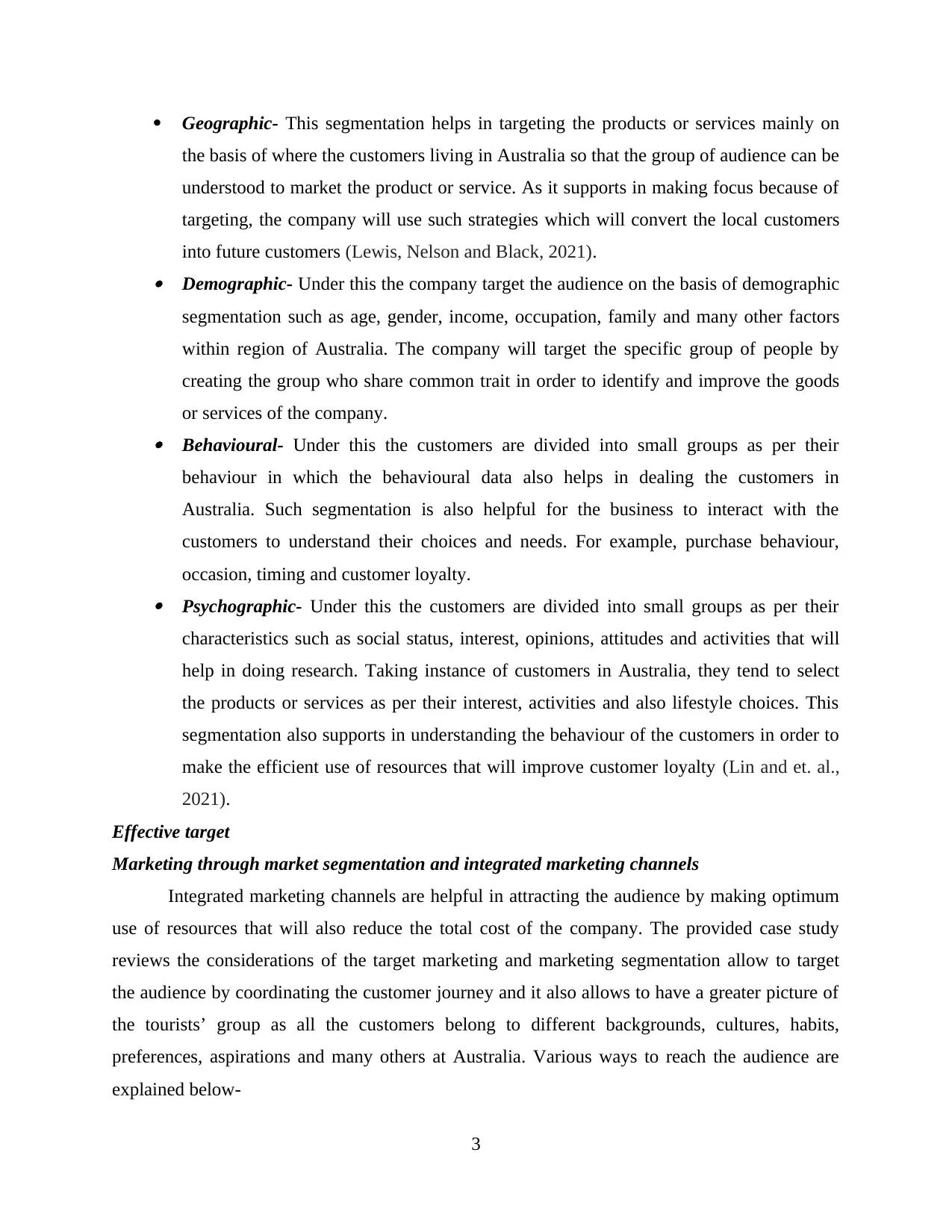
Geographic- This segmentation helps in targeting the products or services mainly on
the basis of where the customers living in Australia so that the group of audience can be
understood to market the product or service. As it supports in making focus because of
targeting, the company will use such strategies which will convert the local customers
into future customers (Lewis, Nelson and Black, 2021). Demographic- Under this the company target the audience on the basis of demographic
segmentation such as age, gender, income, occupation, family and many other factors
within region of Australia. The company will target the specific group of people by
creating the group who share common trait in order to identify and improve the goods
or services of the company. Behavioural- Under this the customers are divided into small groups as per their
behaviour in which the behavioural data also helps in dealing the customers in
Australia. Such segmentation is also helpful for the business to interact with the
customers to understand their choices and needs. For example, purchase behaviour,
occasion, timing and customer loyalty. Psychographic- Under this the customers are divided into small groups as per their
characteristics such as social status, interest, opinions, attitudes and activities that will
help in doing research. Taking instance of customers in Australia, they tend to select
the products or services as per their interest, activities and also lifestyle choices. This
segmentation also supports in understanding the behaviour of the customers in order to
make the efficient use of resources that will improve customer loyalty (Lin and et. al.,
2021).
Effective target
Marketing through market segmentation and integrated marketing channels
Integrated marketing channels are helpful in attracting the audience by making optimum
use of resources that will also reduce the total cost of the company. The provided case study
reviews the considerations of the target marketing and marketing segmentation allow to target
the audience by coordinating the customer journey and it also allows to have a greater picture of
the tourists’ group as all the customers belong to different backgrounds, cultures, habits,
preferences, aspirations and many others at Australia. Various ways to reach the audience are
explained below-
3
the basis of where the customers living in Australia so that the group of audience can be
understood to market the product or service. As it supports in making focus because of
targeting, the company will use such strategies which will convert the local customers
into future customers (Lewis, Nelson and Black, 2021). Demographic- Under this the company target the audience on the basis of demographic
segmentation such as age, gender, income, occupation, family and many other factors
within region of Australia. The company will target the specific group of people by
creating the group who share common trait in order to identify and improve the goods
or services of the company. Behavioural- Under this the customers are divided into small groups as per their
behaviour in which the behavioural data also helps in dealing the customers in
Australia. Such segmentation is also helpful for the business to interact with the
customers to understand their choices and needs. For example, purchase behaviour,
occasion, timing and customer loyalty. Psychographic- Under this the customers are divided into small groups as per their
characteristics such as social status, interest, opinions, attitudes and activities that will
help in doing research. Taking instance of customers in Australia, they tend to select
the products or services as per their interest, activities and also lifestyle choices. This
segmentation also supports in understanding the behaviour of the customers in order to
make the efficient use of resources that will improve customer loyalty (Lin and et. al.,
2021).
Effective target
Marketing through market segmentation and integrated marketing channels
Integrated marketing channels are helpful in attracting the audience by making optimum
use of resources that will also reduce the total cost of the company. The provided case study
reviews the considerations of the target marketing and marketing segmentation allow to target
the audience by coordinating the customer journey and it also allows to have a greater picture of
the tourists’ group as all the customers belong to different backgrounds, cultures, habits,
preferences, aspirations and many others at Australia. Various ways to reach the audience are
explained below-
3
Paraphrase This Document
Need a fresh take? Get an instant paraphrase of this document with our AI Paraphraser

Website development- The company can also make the website attractive by using the
fresh content regularly in order to connect with the audience. People in Australia support
developing the online presence which also ensures increased engagement with company
customers. The websites also contain the address and contact information so that
customers can know about the existence of the business. Moreover, the queries of the
customers can also be resolved through the websites. Ads- It is one of the effective marketing channels to ascertain the situations of the visitors
and their interest in travelling. It further explains the interested audience and those who
are actually interested in buying for example social media ads, video ads, display ads as
these tools help in attracting the audience of their choice. Such ads make it easier to
advertise about the products or services. Due to digital technology, it is now easier to
target customers on the internet through websites, search engines and different websites
sponsorships ads. As the tourism company should research about the target customers so
that they can ascertain about the websites where the customers are spending most of the
time.
Engagement Marketing- This marketing is used to increase the engagement of the
people so that the creditability of the company can be promoted with the help of
promotion. Such marketing enhances the overall experience of the customers regarding
the brand. When more customers interact with the company the brand becomes more
valuable and provide better services (Mirzaei, Carter and Schneider, 2018). Social media- Social media helps in promoting the company and it is one of the best
marketing channel to get the message across. There are various platforms of social media
such as Facebook, Instagram for the purpose of expanding the business. Nowadays, most
of the people are using social media and with the help of proper strategy one can reach
the heights of success. Under this the business can collaborate with the influencers as
influencers are the online celebrities and quickly build the level of trust among the
customers and audience.
Popular travel websites- The companies can take help of popular travel websites in order
to promote the business, the company can make use of popular travel websites which are
trusted and reputable travel websites in order to reach the audience (Summers, Cavaye
and Woolcock, 2019).
4
fresh content regularly in order to connect with the audience. People in Australia support
developing the online presence which also ensures increased engagement with company
customers. The websites also contain the address and contact information so that
customers can know about the existence of the business. Moreover, the queries of the
customers can also be resolved through the websites. Ads- It is one of the effective marketing channels to ascertain the situations of the visitors
and their interest in travelling. It further explains the interested audience and those who
are actually interested in buying for example social media ads, video ads, display ads as
these tools help in attracting the audience of their choice. Such ads make it easier to
advertise about the products or services. Due to digital technology, it is now easier to
target customers on the internet through websites, search engines and different websites
sponsorships ads. As the tourism company should research about the target customers so
that they can ascertain about the websites where the customers are spending most of the
time.
Engagement Marketing- This marketing is used to increase the engagement of the
people so that the creditability of the company can be promoted with the help of
promotion. Such marketing enhances the overall experience of the customers regarding
the brand. When more customers interact with the company the brand becomes more
valuable and provide better services (Mirzaei, Carter and Schneider, 2018). Social media- Social media helps in promoting the company and it is one of the best
marketing channel to get the message across. There are various platforms of social media
such as Facebook, Instagram for the purpose of expanding the business. Nowadays, most
of the people are using social media and with the help of proper strategy one can reach
the heights of success. Under this the business can collaborate with the influencers as
influencers are the online celebrities and quickly build the level of trust among the
customers and audience.
Popular travel websites- The companies can take help of popular travel websites in order
to promote the business, the company can make use of popular travel websites which are
trusted and reputable travel websites in order to reach the audience (Summers, Cavaye
and Woolcock, 2019).
4
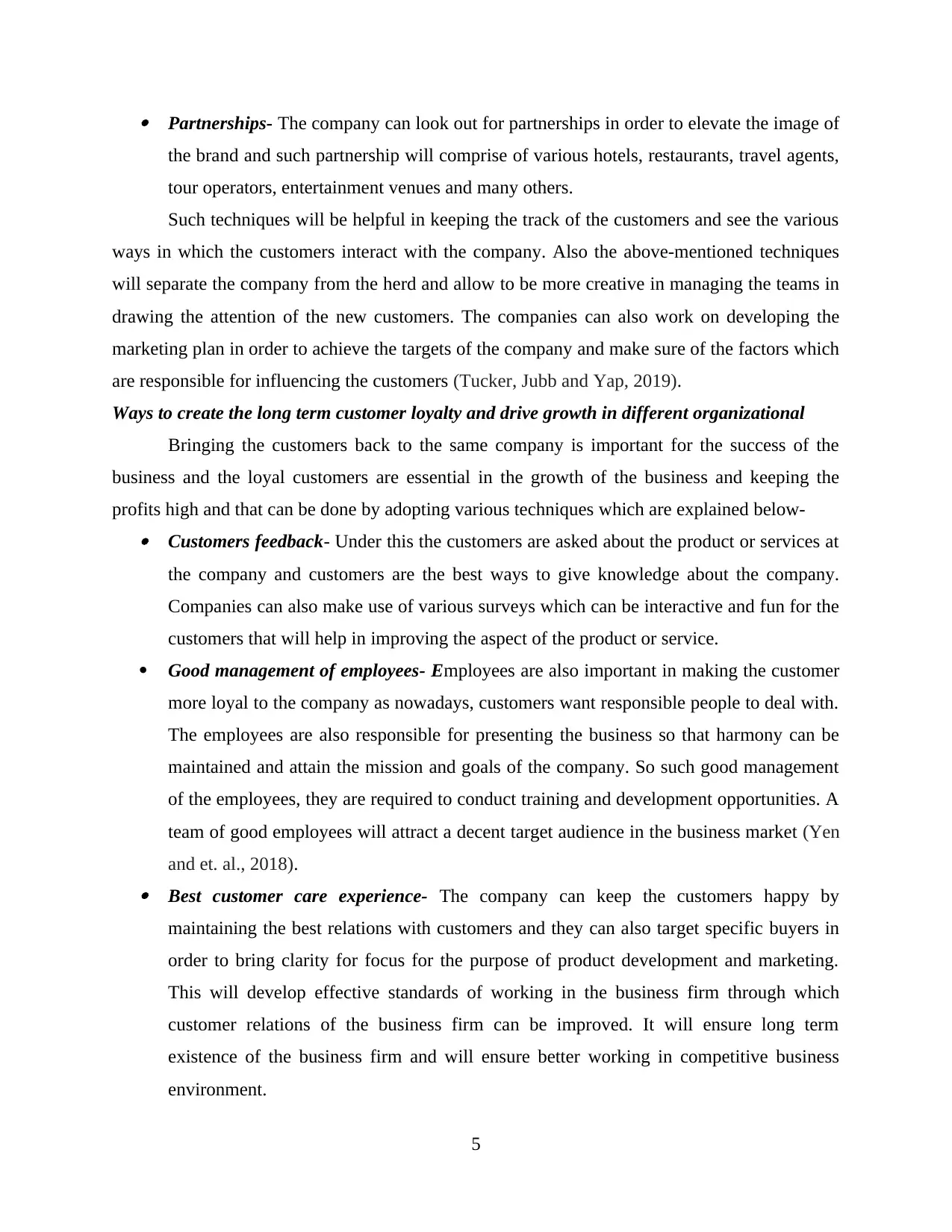
Partnerships- The company can look out for partnerships in order to elevate the image of
the brand and such partnership will comprise of various hotels, restaurants, travel agents,
tour operators, entertainment venues and many others.
Such techniques will be helpful in keeping the track of the customers and see the various
ways in which the customers interact with the company. Also the above-mentioned techniques
will separate the company from the herd and allow to be more creative in managing the teams in
drawing the attention of the new customers. The companies can also work on developing the
marketing plan in order to achieve the targets of the company and make sure of the factors which
are responsible for influencing the customers (Tucker, Jubb and Yap, 2019).
Ways to create the long term customer loyalty and drive growth in different organizational
Bringing the customers back to the same company is important for the success of the
business and the loyal customers are essential in the growth of the business and keeping the
profits high and that can be done by adopting various techniques which are explained below- Customers feedback- Under this the customers are asked about the product or services at
the company and customers are the best ways to give knowledge about the company.
Companies can also make use of various surveys which can be interactive and fun for the
customers that will help in improving the aspect of the product or service.
Good management of employees- Employees are also important in making the customer
more loyal to the company as nowadays, customers want responsible people to deal with.
The employees are also responsible for presenting the business so that harmony can be
maintained and attain the mission and goals of the company. So such good management
of the employees, they are required to conduct training and development opportunities. A
team of good employees will attract a decent target audience in the business market (Yen
and et. al., 2018). Best customer care experience- The company can keep the customers happy by
maintaining the best relations with customers and they can also target specific buyers in
order to bring clarity for focus for the purpose of product development and marketing.
This will develop effective standards of working in the business firm through which
customer relations of the business firm can be improved. It will ensure long term
existence of the business firm and will ensure better working in competitive business
environment.
5
the brand and such partnership will comprise of various hotels, restaurants, travel agents,
tour operators, entertainment venues and many others.
Such techniques will be helpful in keeping the track of the customers and see the various
ways in which the customers interact with the company. Also the above-mentioned techniques
will separate the company from the herd and allow to be more creative in managing the teams in
drawing the attention of the new customers. The companies can also work on developing the
marketing plan in order to achieve the targets of the company and make sure of the factors which
are responsible for influencing the customers (Tucker, Jubb and Yap, 2019).
Ways to create the long term customer loyalty and drive growth in different organizational
Bringing the customers back to the same company is important for the success of the
business and the loyal customers are essential in the growth of the business and keeping the
profits high and that can be done by adopting various techniques which are explained below- Customers feedback- Under this the customers are asked about the product or services at
the company and customers are the best ways to give knowledge about the company.
Companies can also make use of various surveys which can be interactive and fun for the
customers that will help in improving the aspect of the product or service.
Good management of employees- Employees are also important in making the customer
more loyal to the company as nowadays, customers want responsible people to deal with.
The employees are also responsible for presenting the business so that harmony can be
maintained and attain the mission and goals of the company. So such good management
of the employees, they are required to conduct training and development opportunities. A
team of good employees will attract a decent target audience in the business market (Yen
and et. al., 2018). Best customer care experience- The company can keep the customers happy by
maintaining the best relations with customers and they can also target specific buyers in
order to bring clarity for focus for the purpose of product development and marketing.
This will develop effective standards of working in the business firm through which
customer relations of the business firm can be improved. It will ensure long term
existence of the business firm and will ensure better working in competitive business
environment.
5
⊘ This is a preview!⊘
Do you want full access?
Subscribe today to unlock all pages.

Trusted by 1+ million students worldwide
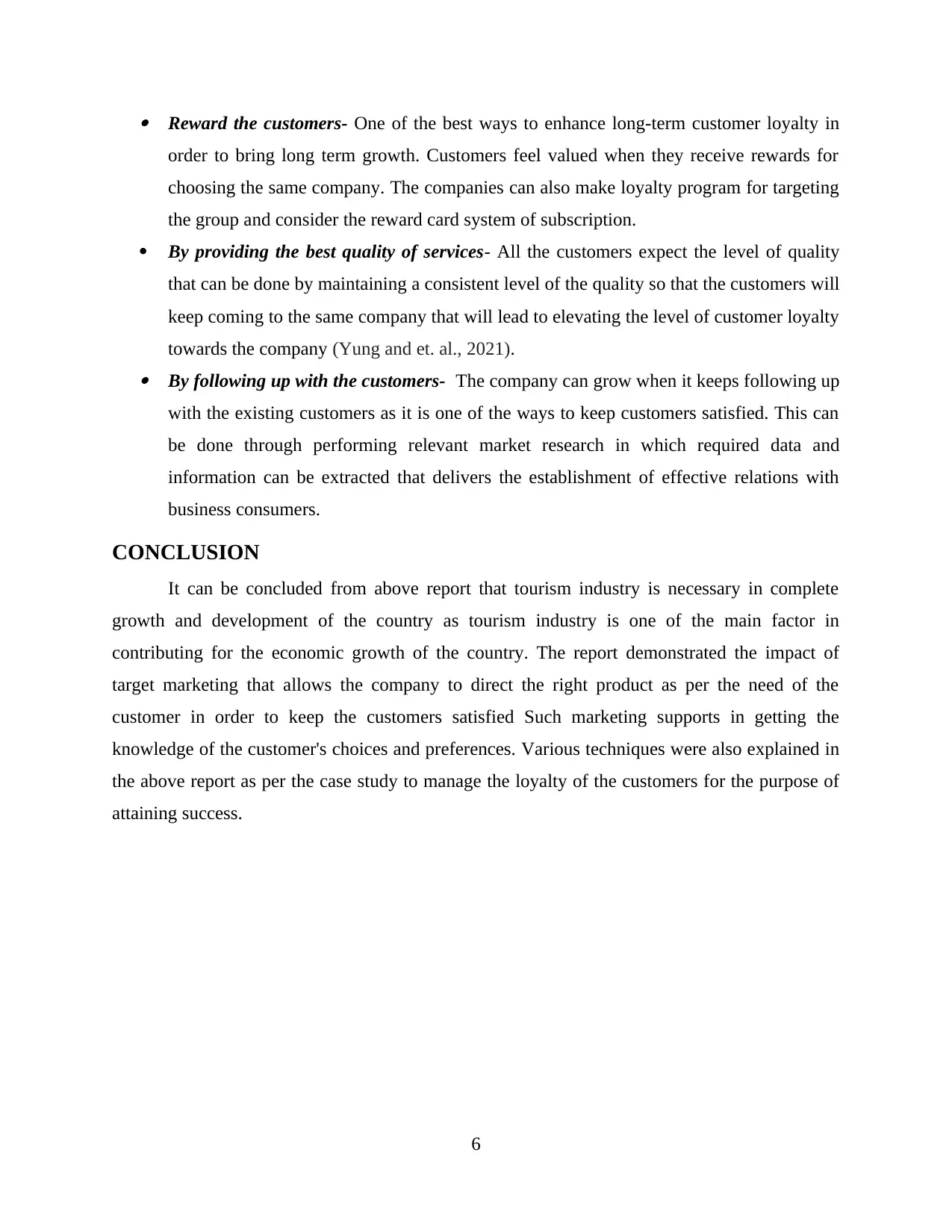
Reward the customers- One of the best ways to enhance long-term customer loyalty in
order to bring long term growth. Customers feel valued when they receive rewards for
choosing the same company. The companies can also make loyalty program for targeting
the group and consider the reward card system of subscription.
By providing the best quality of services- All the customers expect the level of quality
that can be done by maintaining a consistent level of the quality so that the customers will
keep coming to the same company that will lead to elevating the level of customer loyalty
towards the company (Yung and et. al., 2021). By following up with the customers- The company can grow when it keeps following up
with the existing customers as it is one of the ways to keep customers satisfied. This can
be done through performing relevant market research in which required data and
information can be extracted that delivers the establishment of effective relations with
business consumers.
CONCLUSION
It can be concluded from above report that tourism industry is necessary in complete
growth and development of the country as tourism industry is one of the main factor in
contributing for the economic growth of the country. The report demonstrated the impact of
target marketing that allows the company to direct the right product as per the need of the
customer in order to keep the customers satisfied Such marketing supports in getting the
knowledge of the customer's choices and preferences. Various techniques were also explained in
the above report as per the case study to manage the loyalty of the customers for the purpose of
attaining success.
6
order to bring long term growth. Customers feel valued when they receive rewards for
choosing the same company. The companies can also make loyalty program for targeting
the group and consider the reward card system of subscription.
By providing the best quality of services- All the customers expect the level of quality
that can be done by maintaining a consistent level of the quality so that the customers will
keep coming to the same company that will lead to elevating the level of customer loyalty
towards the company (Yung and et. al., 2021). By following up with the customers- The company can grow when it keeps following up
with the existing customers as it is one of the ways to keep customers satisfied. This can
be done through performing relevant market research in which required data and
information can be extracted that delivers the establishment of effective relations with
business consumers.
CONCLUSION
It can be concluded from above report that tourism industry is necessary in complete
growth and development of the country as tourism industry is one of the main factor in
contributing for the economic growth of the country. The report demonstrated the impact of
target marketing that allows the company to direct the right product as per the need of the
customer in order to keep the customers satisfied Such marketing supports in getting the
knowledge of the customer's choices and preferences. Various techniques were also explained in
the above report as per the case study to manage the loyalty of the customers for the purpose of
attaining success.
6
Paraphrase This Document
Need a fresh take? Get an instant paraphrase of this document with our AI Paraphraser

REFERENCES
Books and Journal
Carr, C., McGuirk, P. and Dowling, R., 2019. Geographies of energy transition: the case of high-
performing commercial office space in the central business districts of Sydney and
Melbourne, Australia. Australian Geographer, 50(1), pp.29-48.
Chaudhary, R. and Bisai, S., 2018. Factors influencing green purchase behavior of millennials in
India. Management of Environmental Quality: An International Journal.
Dolnicar, S., 2019. Market segmentation analysis in tourism: a perspective paper. Tourism
Review.
Lewis, C., Nelson, K. and Black, R., 2021. Moving Millennials out of the too hard basket:
Exploring the challenges of attracting Millennial tourists to rural destinations. Journal
of Hospitality and Tourism Management, 46, pp.96-103.
Lin, P.M., Ok, C.M. and Ching Au, W., 2021. Peer-to-peer dining: a motivation study. Journal
of Hospitality & Tourism Research, p.1096348021990709.
Mirzaei, A., Carter, S.R. and Schneider, C.R., 2018. Marketing activity in the community
pharmacy sector–a scoping review. Research in Social and Administrative
Pharmacy, 14(2), pp.127-137.
Summers, J., Cavaye, J. and Woolcock, G., 2019. Enablers and barriers of tourism as a driver of
economic and social‐cultural growth in remote Queensland. Economic Papers: A
journal of applied economics and policy, 38(2), pp.77-94.
Tucker, M., Jubb, C. and Yap, C.J., 2019. The theory of planned behaviour and student banking
in Australia. International Journal of Bank Marketing.
Yen, B.T., Mulley, C., Tseng, W.C. and Chiou, Y.C., 2018. Assessing interchange effects in
public transport: A case study of South East Queensland, Australia. Case studies on
transport policy, 6(3), pp.364-375.
Yung, R., Khoo-Lattimore, C., Prayag, G. and Surovaya, E., 2021. Around the world in less than
a day: virtual reality, destination image and perceived destination choice risk in family
tourism. Tourism Recreation Research, 46(1), pp.3-18.
7
Books and Journal
Carr, C., McGuirk, P. and Dowling, R., 2019. Geographies of energy transition: the case of high-
performing commercial office space in the central business districts of Sydney and
Melbourne, Australia. Australian Geographer, 50(1), pp.29-48.
Chaudhary, R. and Bisai, S., 2018. Factors influencing green purchase behavior of millennials in
India. Management of Environmental Quality: An International Journal.
Dolnicar, S., 2019. Market segmentation analysis in tourism: a perspective paper. Tourism
Review.
Lewis, C., Nelson, K. and Black, R., 2021. Moving Millennials out of the too hard basket:
Exploring the challenges of attracting Millennial tourists to rural destinations. Journal
of Hospitality and Tourism Management, 46, pp.96-103.
Lin, P.M., Ok, C.M. and Ching Au, W., 2021. Peer-to-peer dining: a motivation study. Journal
of Hospitality & Tourism Research, p.1096348021990709.
Mirzaei, A., Carter, S.R. and Schneider, C.R., 2018. Marketing activity in the community
pharmacy sector–a scoping review. Research in Social and Administrative
Pharmacy, 14(2), pp.127-137.
Summers, J., Cavaye, J. and Woolcock, G., 2019. Enablers and barriers of tourism as a driver of
economic and social‐cultural growth in remote Queensland. Economic Papers: A
journal of applied economics and policy, 38(2), pp.77-94.
Tucker, M., Jubb, C. and Yap, C.J., 2019. The theory of planned behaviour and student banking
in Australia. International Journal of Bank Marketing.
Yen, B.T., Mulley, C., Tseng, W.C. and Chiou, Y.C., 2018. Assessing interchange effects in
public transport: A case study of South East Queensland, Australia. Case studies on
transport policy, 6(3), pp.364-375.
Yung, R., Khoo-Lattimore, C., Prayag, G. and Surovaya, E., 2021. Around the world in less than
a day: virtual reality, destination image and perceived destination choice risk in family
tourism. Tourism Recreation Research, 46(1), pp.3-18.
7
1 out of 8
Related Documents
Your All-in-One AI-Powered Toolkit for Academic Success.
+13062052269
info@desklib.com
Available 24*7 on WhatsApp / Email
![[object Object]](/_next/static/media/star-bottom.7253800d.svg)
Unlock your academic potential
Copyright © 2020–2025 A2Z Services. All Rights Reserved. Developed and managed by ZUCOL.





